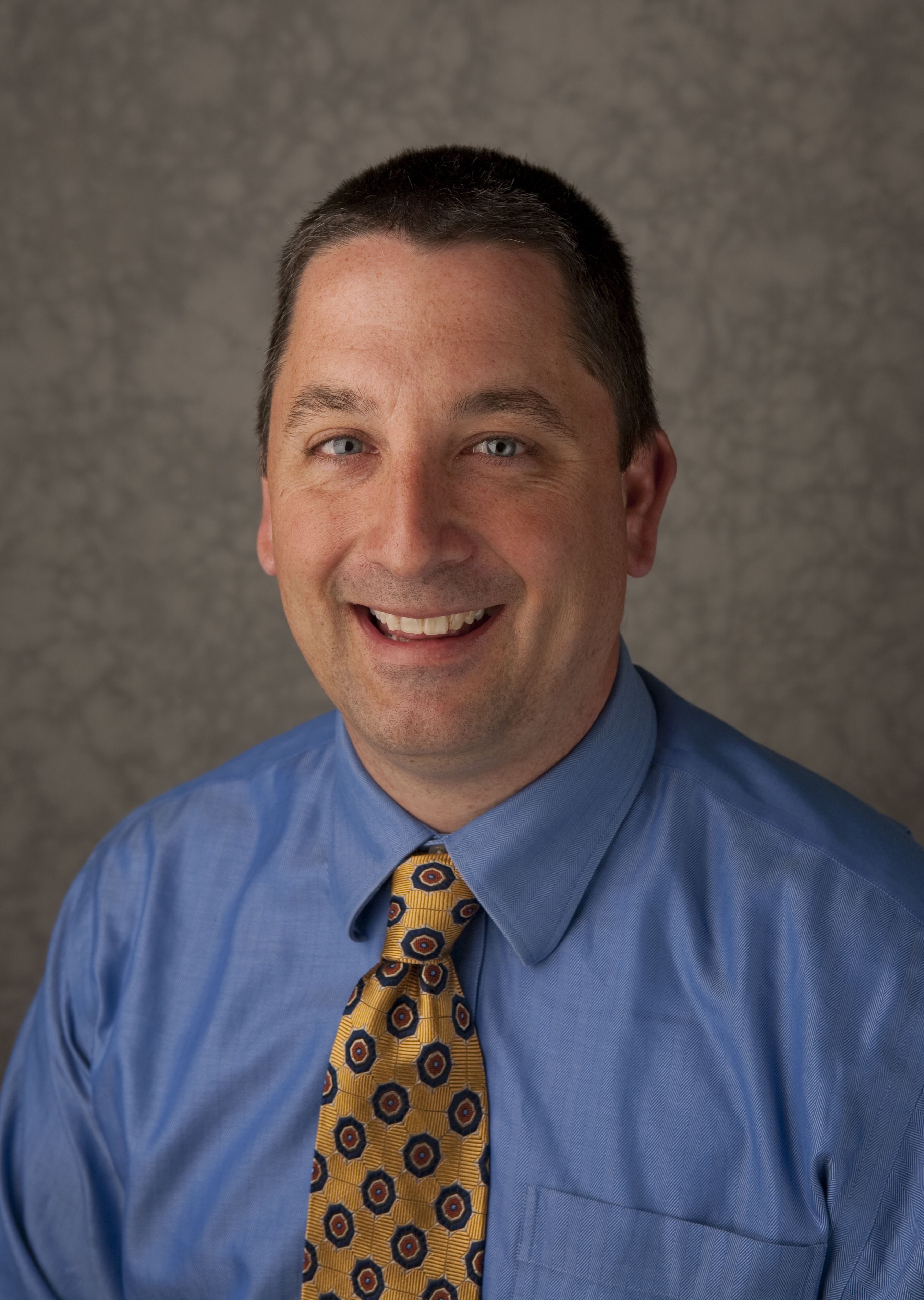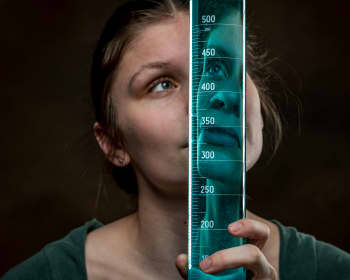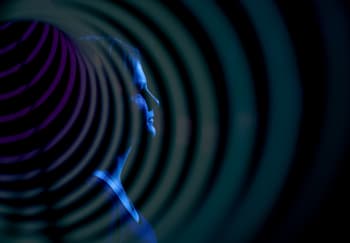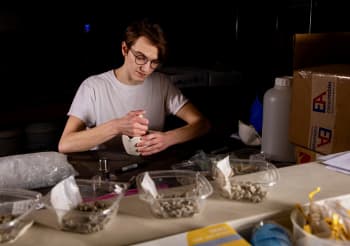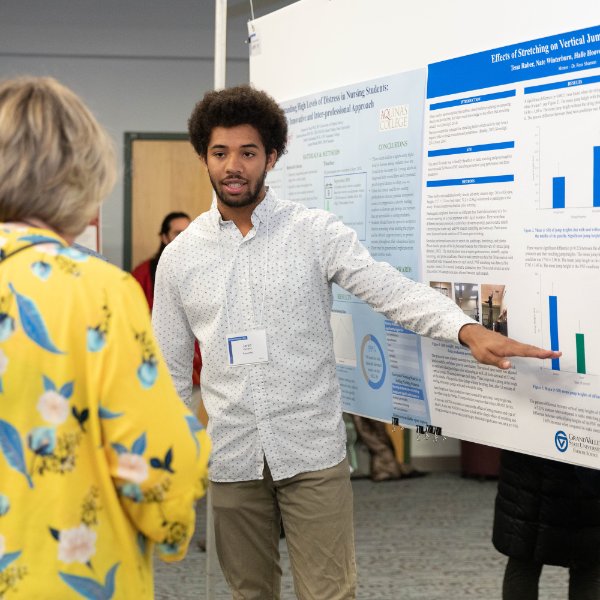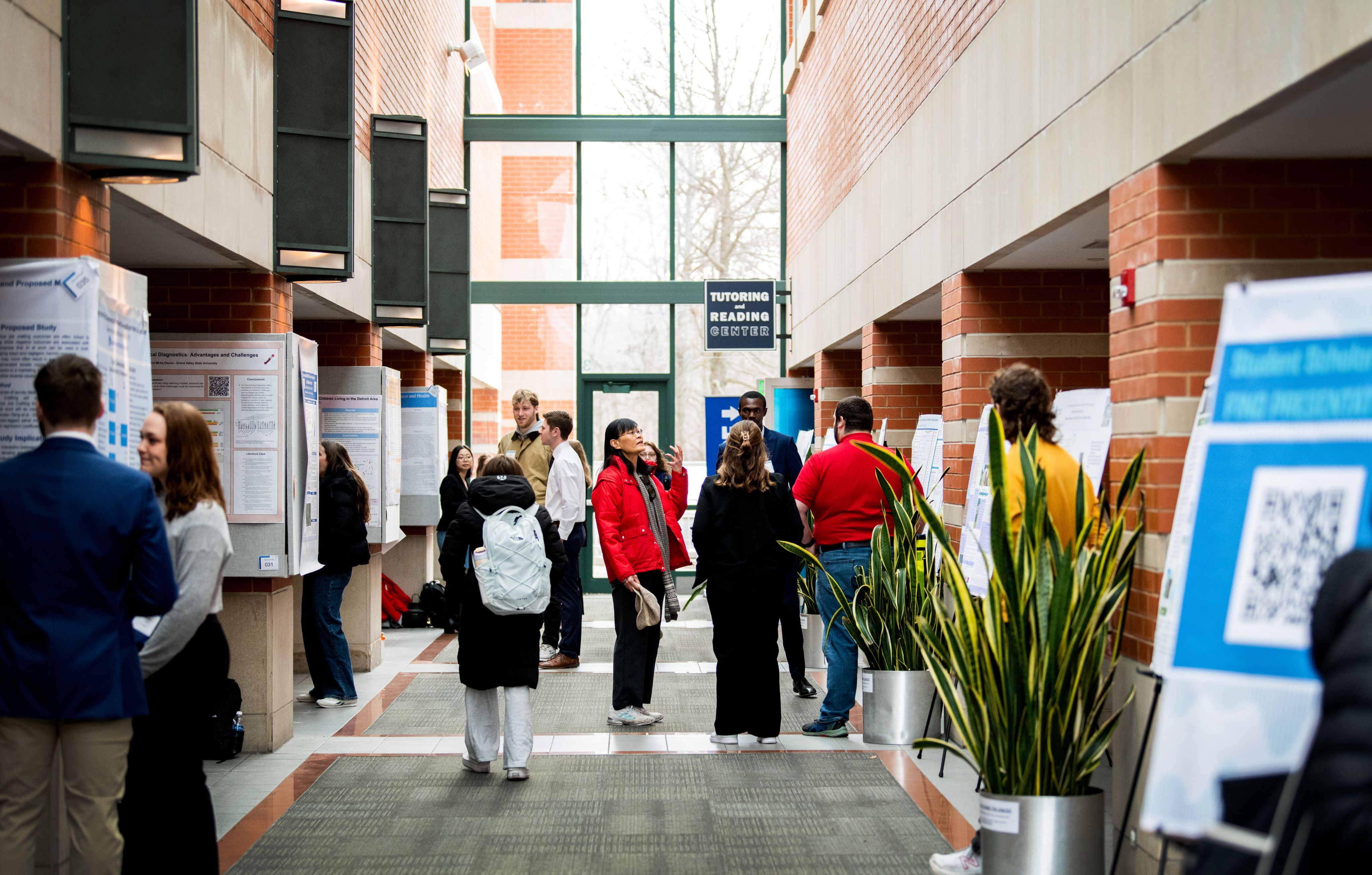
Ask Robert Smart, vice provost of research administration and executive director of the Center for Scholarly and Creative Excellence, about the significance of Student Scholars Day, and he'll turn to a sports analogy to convey what it means to him.
“It's like my Super Bowl," Smart said. "It's one of the best days of the year at Grand Valley.
“At Student Scholars Day, I get to see why we’re the institution that we are. It’s about faculty-student engagement, and this is the purest form of that.”
Across the Allendale campus, more than 500 undergraduate and graduate students participated in this year’s Student Scholars Day, GVSU's annual celebration of student research and faculty mentorship.
Posters and easels filled the atrium and hallways of Henry Hall as students discussed their presentations with faculty and their peers. In the Kirkhof Center's Grand River Room, students proudly discussed their research as Smart, President Philomena V. Mantella, and Provost Jennifer Drake engaged with them in conversation.
The event showcases more than research presentations. Students also unveiled artwork, film and video segments, mini-zines and podcasts and also gave live performances. Students' artwork will be exhibited from April 7-25 at the Calder Art Center.
This year's Student Scholars Day kicked off on April 8 with a keynote address by Shobita Parthasarathy, professor of public policy and women’s and gender studies, and director of the Science, Technology and Public Policy Program at the University of Michigan.
Robert Smart, vice provost for research administration and executive director for the Center for Scholarly and Creative Excellence
Robert Smart, vice provost for research administration and executive director for the Center for Scholarly and Creative Excellence
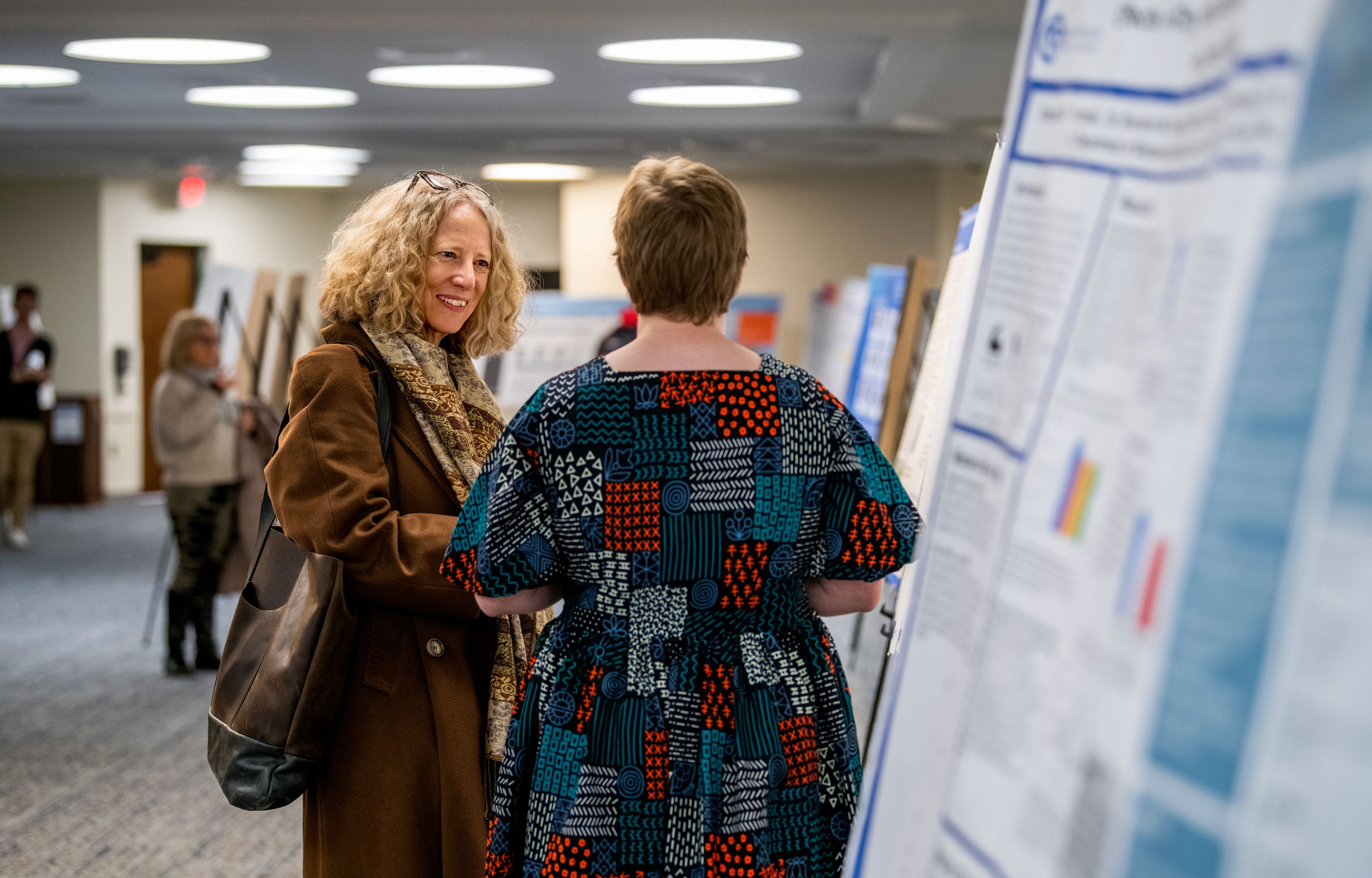
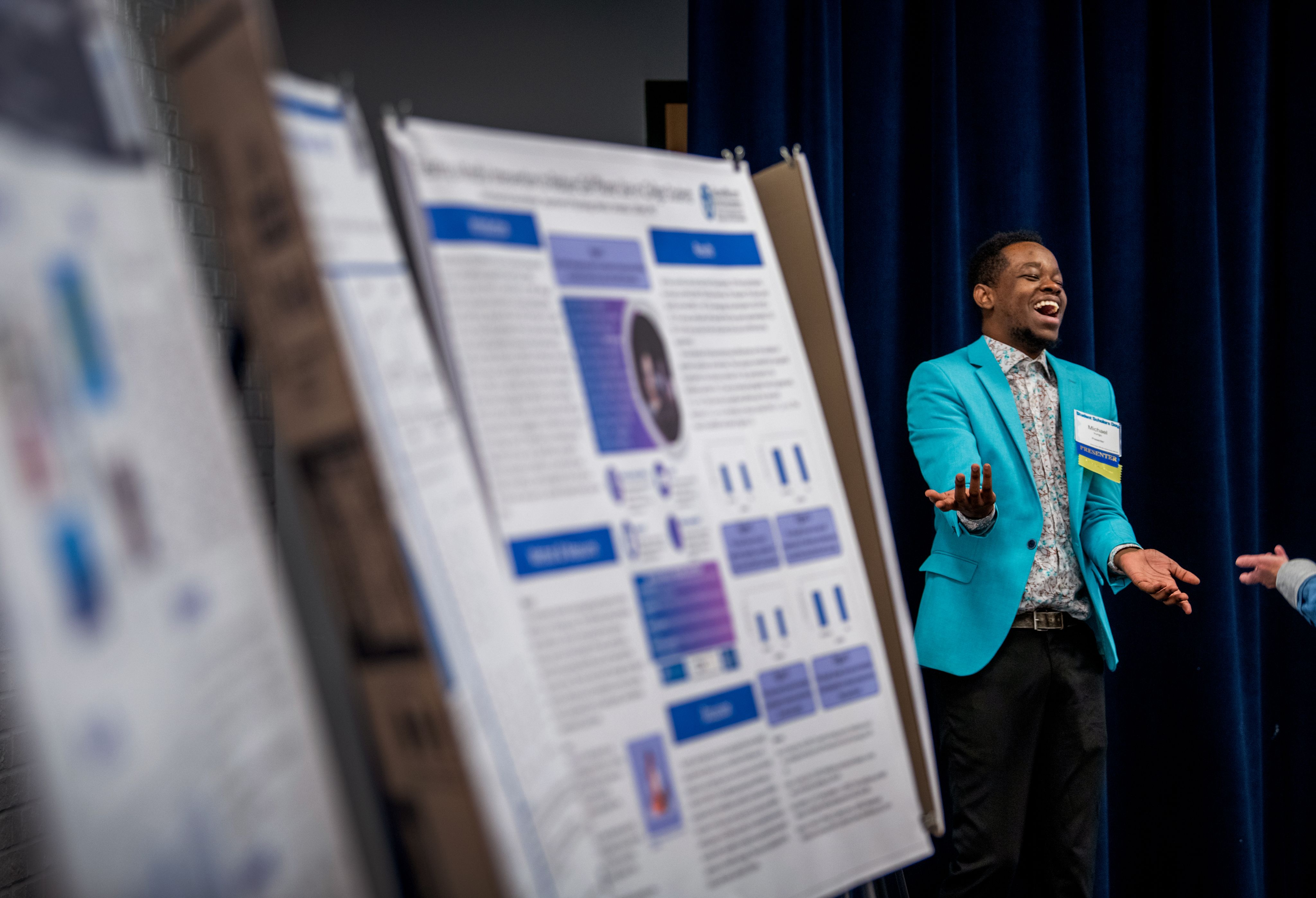
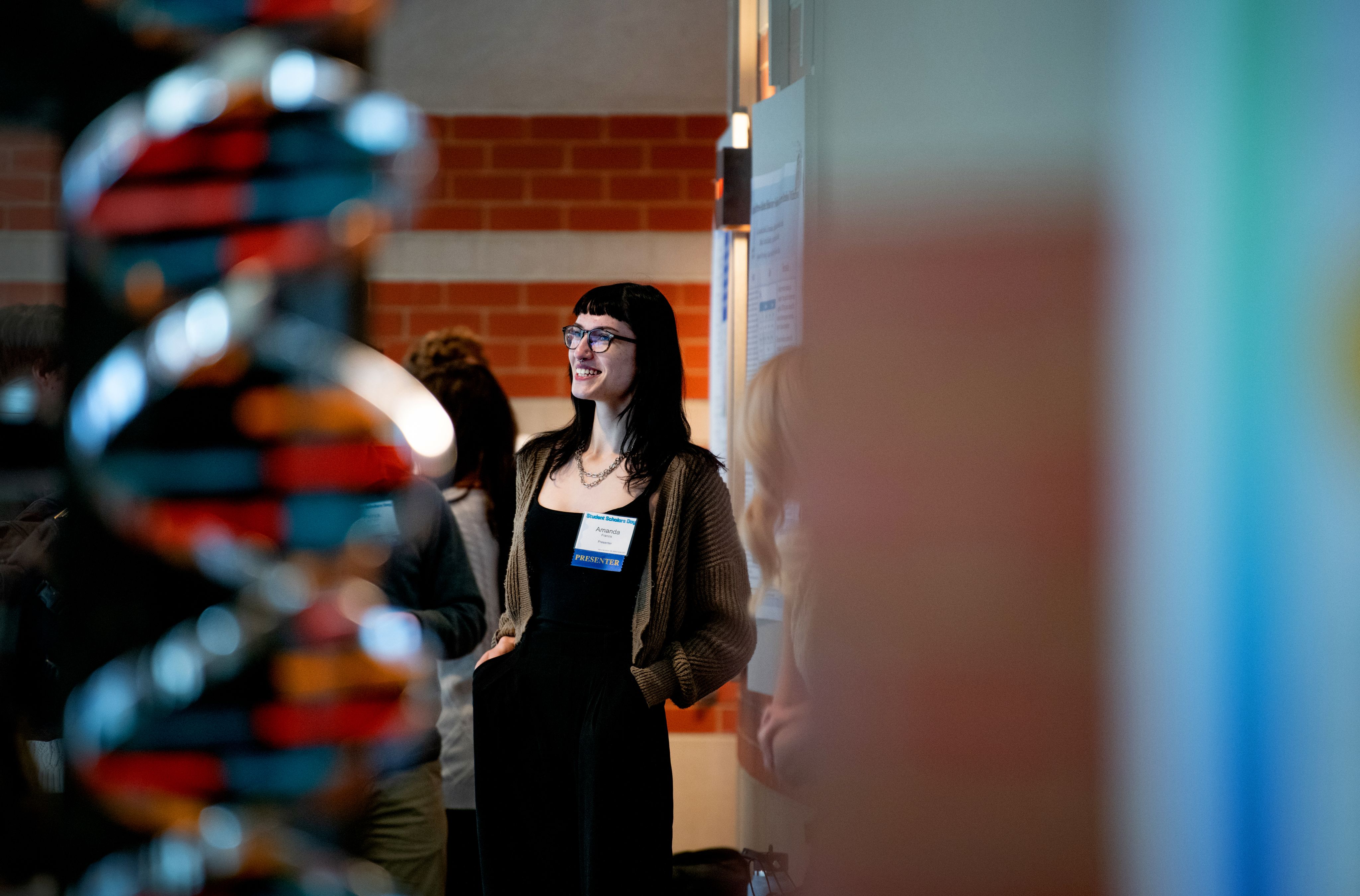
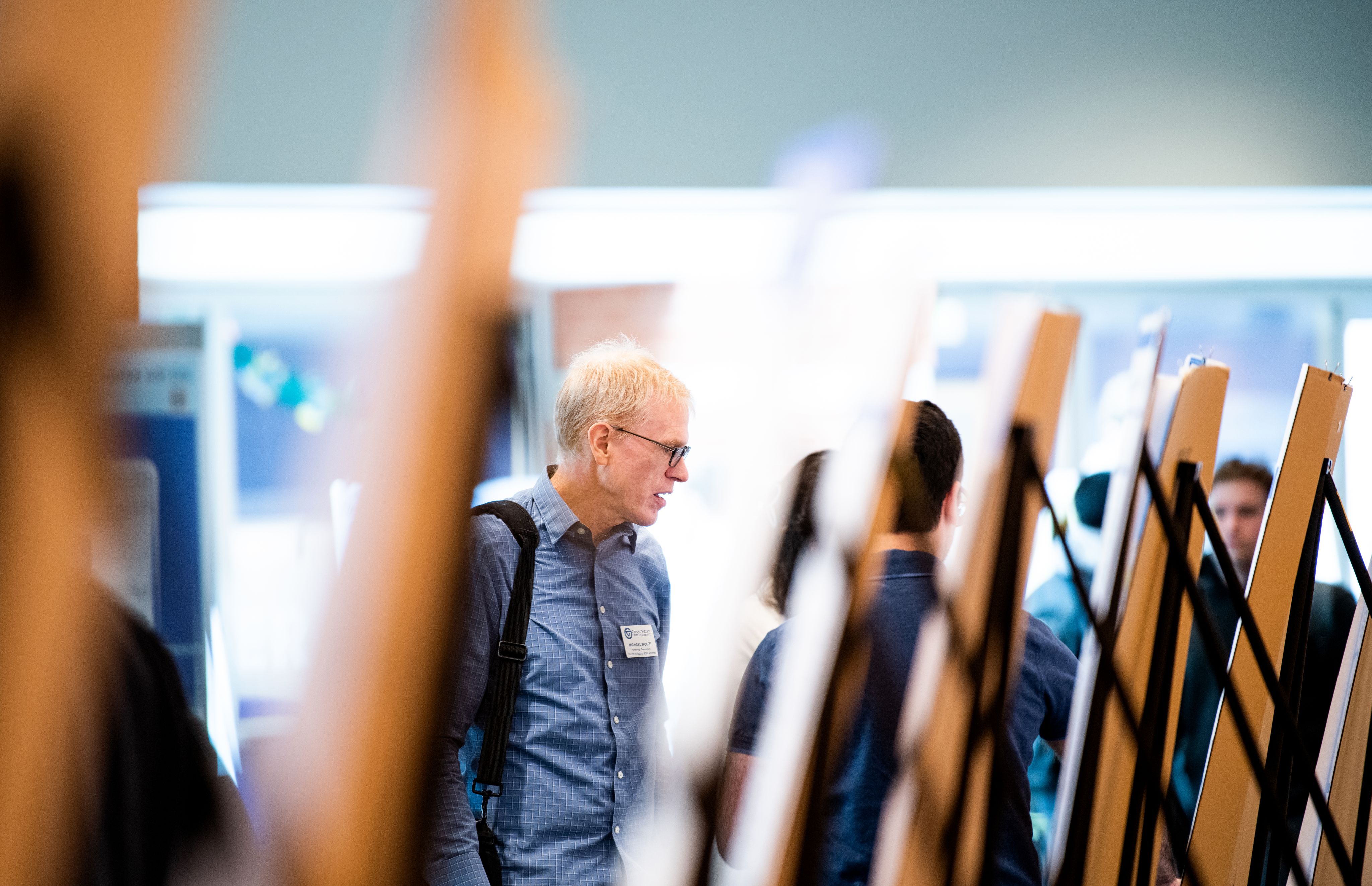
Eric Miller, director of talent and employee engagement at the Van Andel Institute, said the Student Scholars Day experience is a paramount opportunity for students to apply their learning beyond the classroom. Miller was one of several local representatives to visit with students during an employee panel and networking breakfast.
“(Student Scholars Day) is giving them a real experience of what they could potentially be doing later,” Miller said. “Absolutely, it will prepare them. The classroom only takes you so far. You have to expand and take that next step in the process.
“You just can’t come out with a diploma anymore. You have to have hands-on experience in a lab. You have to demonstrate that you can do experiments and follow protocols and can troubleshoot and think critically.”
For nearly 30 years, Student Scholars Day at GVSU has provided students opportunities to collaborate with faculty mentors, expand their academic interests and contribute to the advancement of their field of study.
The following profiles highlight four students who participated in this year's Student Scholars Day and shared insights from their research experiences.
Whether in the lab, the library or the community, these four students represent a collective that embodies the curiosity, creativity and dedication that drive discovery and innovation.
Lilly Helsel, chemistry
Junior Lilly Helsel is working toward her degree in biomedical sciences with her goal of earning her medical degree. However, an unexpected opportunity in her first-year chemistry class introduced her to the world of educational research, she said.
“I had (chemistry faculty member Brittland DeKorver) as a professor, and I just really loved her methods of teaching. It made me understand chemistry in a way that I’ve never understood before.”
Helsel’s project applied DeKorver’s own research in chemistry classrooms. Essentially, DeKorver and Helsel are testing teaching methods and learning objectives in high school chemistry classes to identify effective techniques of engaging with students.
Helsel explained that while dramatic chemistry demonstrations — such as explosions or striking color changes — can capture students' attention, they don’t always help them retain core concepts.
“That’s why we need other methods of teaching these concepts, and that's kind of what my research focuses on, developing a different method to teach these concepts, which professor DeKorver has developed, and I'm testing them for her,” Helsel said.
Helsel has been joining DeKorver on her visits to a Montessori school in Grand Rapids, interacting with different chemistry classes and noting students’ responses.
“We always ask the students a question, and they'll write down an answer, and then after we perform the demonstration in a way that's effective, you can often see the realization on their faces of how they're understanding the concept as a whole rather than just seeing a ‘Wow’ demonstration,” Helsel said.
The research experience has left a profound impression on her, Helsel said.
“If I already wasn't on my medical school journey and wanted to be a doctor, I'd probably double back and go into education just because of this research project.”
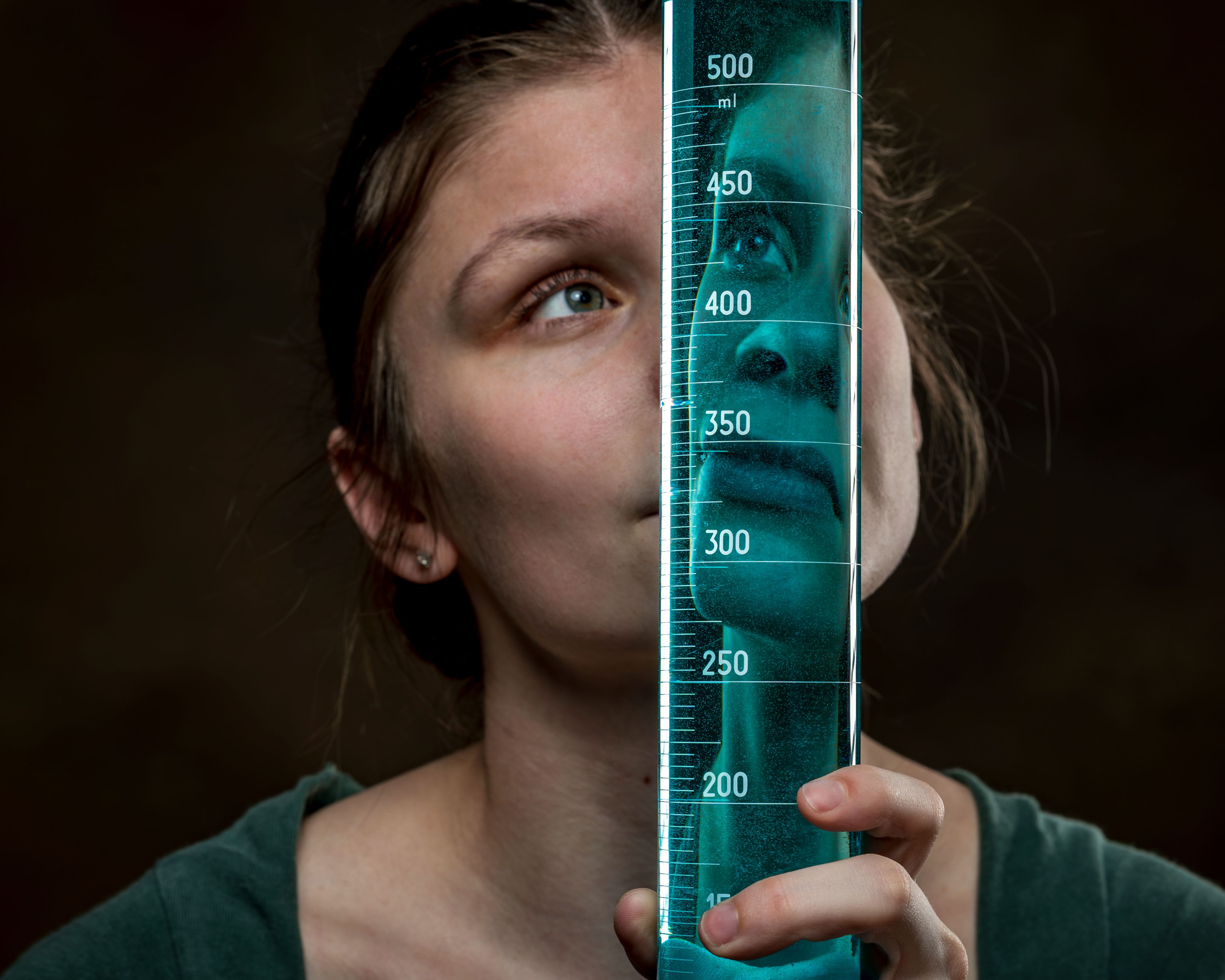
Savannah Tormala, biomedical sciences
During her time at GVSU, senior Savannah Tormala was eager to pursue undergraduate research. Working under the mentorship of Eric Ramsson, professor of biomedical sciences, Tormala said she found her experience deeply impactful.
“It’s something that I will take with me, not just the research aspect of it,” Tormala said. “It shaped me by instilling a passion for discovery and providing a profound memory of the journey. I’ll look back at the experience with gratitude and pride.”
Tormala’s work assisting Ramsson focused on relaxation techniques and methods for participants, specifically dry needling, craniosacral therapy and sound vibration. The duo studied how these methods affect the participants' brain waves, their autonomic regulation and muscle tension.
“These three techniques trigger the human autonomic nervous system, which is your ‘rest and digest’ or ‘fight or flight’ mechanisms,” Tormala said. “So they would make the individual feel more rested and most relaxed overall.”
Dry needling involves the placement of needles to target a specific muscle and relieve tension. Craniosacral therapy massages certain nerve points on the head while sound vibration incorporates tuning forks, tones and audio frequencies to trigger the body's natural calming response.
Tormala said she credits her experience in research to the guidance and encouragement of Ramsson, her fellow research students and the Office of Undergraduate Research and Scholarship.
“The support I received with my mentor, research students and the Office of Undergraduate Research and Scholarship through their encouragement and wisdom was fundamental to navigate the challenges and expand my growth,” Tormala said.
“You'll make mistakes in research, and mistakes happen all the time, but for them to support and guide you through those, I think I'll be forever grateful for that opportunity to work alongside them and have the opportunity.”

Breezy Rusher, history
As Breezy Rusher concludes his final year as a double major in group social studies and secondary education, he had the opportunity to participate in an undergraduate research project.
Rusher said his research project about the experience of Black educators from the 1970s to 1990s drew from his educational background in history and education, as well as his own lived experience.
“This project aims to provide a richer and more informed understanding of the role and impact of Black educators in history, addressing gaps in historical scholarship and emphasizing the significance of their lived experiences to the field of education,” Rusher said.
By promoting his research on Student Scholars Day, Rusher hopes to teach others about the importance of the voices of people of color in academia.
“Presenting this project allows me to actually be an example of what we can do now by listening to Black educators who are doing research,” Rusher said.
Rusher plans to continue his education and become an education professor himself, so having opportunities like Student Scholars Day allows him to gain teaching experience.
“I can practice disseminating information to a wide variety of audiences and engage in academic and intellectual conversation with both experts and the general public who are familiar with my fields and discipline,” Rusher said.
— Annie Pettit is a student writer for University Communications.
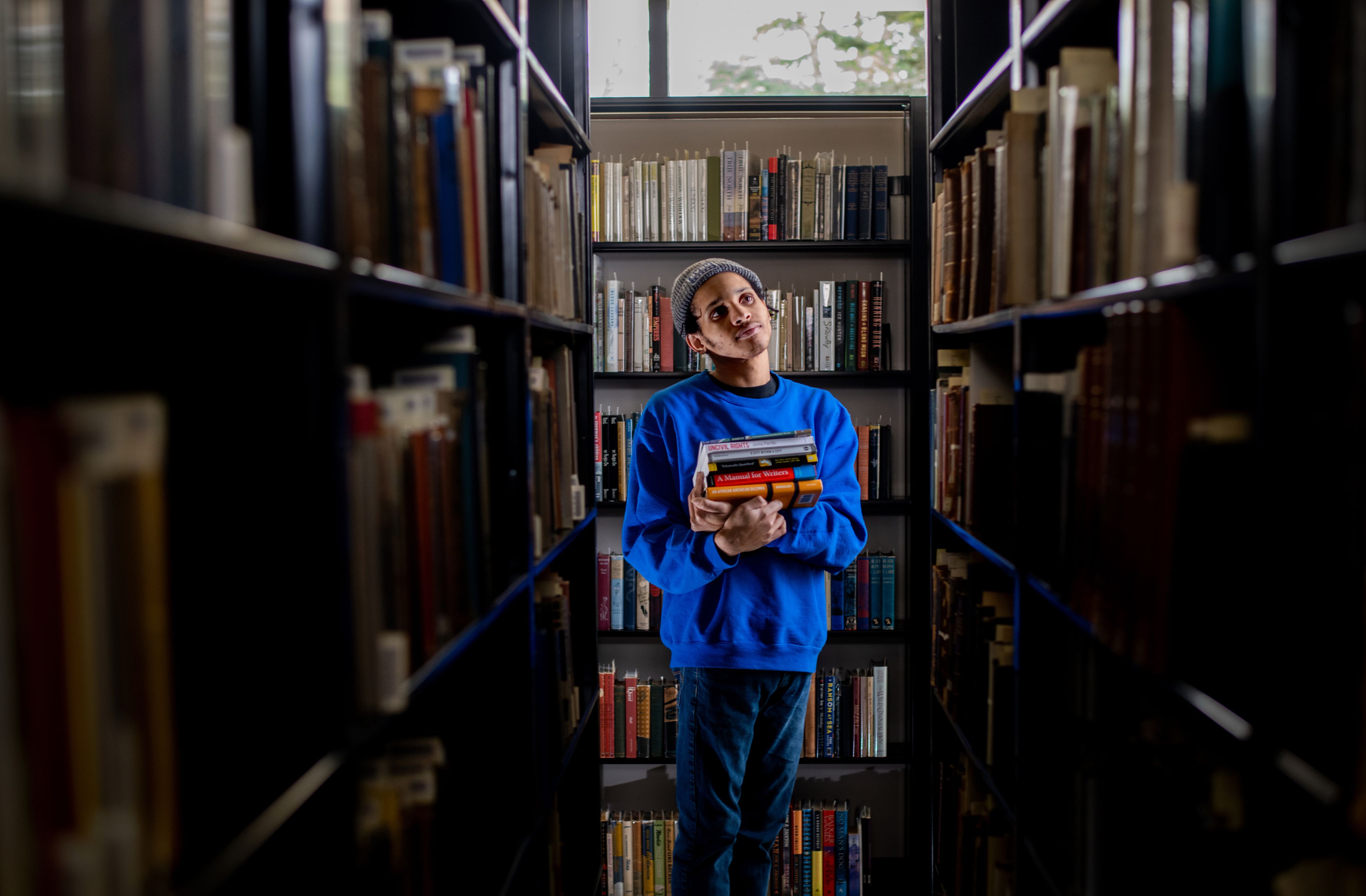
Noah Valentine, geology
Third-year geology major Noah Valentine may be focused on the ground beneath him, but the sky's the limit for his career.
Through GVSU’s Student Summer Scholars program, Valentine worked with Ian Winkelstern, assistant professor of geology, studying the dolomite formations in Sugarloaf Key, Florida.
Dolomite, which forms when limestone interacts with magnesium-rich water, is common throughout the geological record but rare in the Holocene epoch, which began approximately 10,000 years ago. The formations in Florida represent one of the few known sites of Holocene-era dolomitization, making them a point of significant interest for geologists.
“My mentor Ian and I wanted to revisit the sample locations where Holocene dolomites had been sampled and analyzed by geologists back in the 1960s and 1980s,” Valentine said.
By collecting and analyzing new samples, Valentine expands on earlier work, using geochemical techniques to track environmental changes — such as historical water temperatures — by measuring oxygen isotopes in the water and minerals.
Presenting his data at Student Scholars Day, Valentine said, has helped him develop valuable public speaking skills. Looking ahead, he plans to apply his geology background as an environmental consultant.
“With geology, there is potential to get into a wide range of fields,” Valentine said. “I can see myself coming back to conduct climatology research at a university and teaching there as well.”
— Annie Pettit is a student writer for University Communications.









